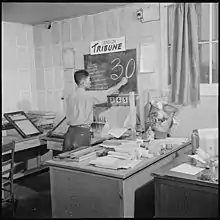-30-
-30- has been traditionally used by journalists in North America to indicate the end of a story or article that is submitted for editing and typesetting. It is commonly employed when writing on deadline and sending bits of the story at a time, via telegraphy, teletype, electronic transmission, or paper copy, as a necessary way to indicate the end of the article.[1] It is also found at the end of press releases.

There are many theories as to how the usage came into being,[2][3] and why it is found in North America but not in other Anglophone nations. One theory is that the journalistic employment of -30- originated from the number's use during the American Civil War era in the 92 Code of telegraphic shorthand, where it signified the end of a transmission[4] and that it found further favor when it was included in the Phillips Code of abbreviations and short markings for common use that was developed by the Associated Press wire service. Telegraph operators familiar with numeric wire signals such as the 92 Code used these railroad codes to provide logistics instructions and train orders, and they adapted them to notate an article's priority or confirm its transmission and receipt. This meta-data would occasionally appear in print when typesetters included the codes in newspapers,[5] especially the code for "No more - the end", which was presented as "- 30 -" on a typewriter.
A poignant example appeared in a sketch by famed WWII cartoonist Bill Mauldin who in paying tribute to equally famed WWII battle correspondent Ernie Pyle just killed in action in the Pacific War by a Japanese sniper simply drew an old-style correspondent's typewriter with a half-rolled sheet of paper that showed simply
"Ernie Pyle
-30- ".
This raises the question of why the number 30 was chosen by 19th century telegraphers to represent "the end." Folk etymology has it that it may have been a joking reference to the Biblical Book of John 19:30, which, in the popular King James Version, appears as:
"30 When Jesus therefore had received the vinegar, he said, It is finished: and he bowed his head, and gave up the ghost."
In popular culture
- The 1952 film Park Row, about the birth of the New York Globe in 1886, ends with the word "THIRTY" displayed instead of "THE END".
- -30- is a 1959 motion picture about work in a Los Angeles newspaper directed by, produced by, and starring Jack Webb.
- In several Superman stories from various titles, failure by a Daily Planet employee to use this signature proved to be a plot point revealing a character's impersonation, mind control, etc.
- "30" is an episode of the television series Law & Order: Criminal Intent about a poisoned reporter.
- "-30-" is the series finale of the television series The Wire (2002–2008), capping a season concerning the media and The Baltimore Sun.
- In Quebec, a journalism magazine published by the Fédération professionnelle des journalistes du Québec is called -trente-,[6] the French word for thirty.
References
- "So Why Not 29". Retrieved 2018-04-27.
- Kogan, Hadass (2007). "So Why Not 29?". Archived from the original on 2010-12-12. Retrieved 2016-05-22.
- Melton, Rob (2008). "The Newswriter's Handbook: The Word: origin of the end mark -30-" (PDF). Journalism Education Association. p. 9. Archived from the original (PDF) on 2015-11-29. Retrieved 2016-05-22.
- "WESTERN UNION "92 CODE" & WOOD'S "TELEGRAPHIC NUMERALS"". Signal Corps Association. 1996. Retrieved 2008-02-25.
- "So Why Not 29?". American Journalism Review - Oct/Nov 2007. Archived from the original on 2010-12-12. Retrieved 2009-01-25.
- "Le -trente-". Fédération professionnelle des journalistes du Québec. Archived from the original on 2019-01-26. Retrieved 2015-01-05.